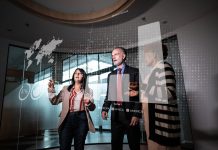Ian Newbury, Business Development Director, Mobile Network Operators & Digital Infrastructure at BT Wholesale, examines how to open the gateway to digital infrastructure that connects all communities
Our industry has made remarkable progress in connecting communities. Gone are the days when payphones were the primary method for remaining connected when away from the home or the office; now 98% of the nation’s adult population can access connectivity via a mobile phone. This has only been possible through massive investment in network coverage across the UK from the Mobile Network Operators (MNOs).
Alongside fibre and macro deployments, small cells play a pivotal role in enhancing network capacity for current and future generations. At BT Wholesale, we have deployed thousands nationwide on a variety of street furniture, such as lampposts and CCTV columns, as well as our heritage payphone estate. Utilising our access to more than 2.5 million street assets, including extensive relationships with 39 local authorities and boroughs, these small cell deployments signify BT Wholesale’s commitment to delivering faster and more reliable connectivity for all.
Digital infrastructure: A greater demand for connectivity
Our reliance on technology has reached unprecedented heights. Mobile phones can serve as contactless payment devices, so people no longer carry a wallet, while some vehicles can be unlocked and started through just an app; there’s no need for a physical key. Evolution is spanning far beyond smartphones now, too, with the integration of connected cars, the Internet of Things (IoT), and other emerging technologies set to create smart homes and cities.
However, the rise of these innovations, which will become much more latency-sensitive, creates more pressure on the network supporting them. They not only increase demand on network traffic, but they require a higher performing network generally. Any challenges impact latency and connectivity reliability, and if the signal is disrupted for any reason, it will have a negative effect on devices and their performance.
Catering to increasing demands and delivering future-proofed connectivity requires a strategic blend of fibre, macro and small cell deployments. Densifying network infrastructure is imperative to create the capacity and reliability required to enable a more connected world.
Recognising the significance of bolstering mobile connectivity and digital infrastructure, Ofcom has taken a proactive stance, announcing the auction of 6GHz of millimetre-wave spectrum frequency across the 26GHz and 40GHz bands. These frequencies are especially well-suited for delivering 5G in densely populated areas, ensuring urban centres are at the forefront of the connectivity revolution.
To reap the full potential of this opportunity, unlocking additional existing street assets for small cell deployments is vital for facilitating better connectivity and smart cities. Without it, increasing network capability may mean more street clutter to host equipment, which impacts space and aesthetics and moves towards net zero through the additional resources required to build and maintain.
Ensuring connectivity for all
Everyone deserves connectivity, and the government has committed to bridging the UK’s digital divide in more remote areas. This is because rural populations face barriers to getting online and gaining digital skills. In fact, 9.5 million UK adults lack basic digital skills, and 5.9 million of those have never been online, with the areas with the highest rate of non-internet users being rural ones.
This has triggered the creation of programmes such as the Shared Rural Network (SRN). The SRN is committed to connecting even the most remote areas and breaking down barriers to digital inclusion. It is working to address connectivity ‘not spots’ and enable communities outside urban areas to benefit from better mobile coverage.
The UK aims to reach 95% geographic coverage with 4G by the mid-2020s. There are notable deadlines to meet between now and then, with the closest upcoming goal of 88% geographic coverage by June 2024. EE recently announced 139 upgrades of 4G sites across Northern Ireland, taking its upgrades under the SRN programme to over 1,500 locations across the UK, putting it on track to meet Ofcom’s 2024 deadline.
Rural communities stand to gain significantly from these initiatives, as various sectors, including farming, tourism, education, and healthcare, rely heavily on seamless digital connections. Also, for technology such as self-driving cars to ever achieve the Centralised Automated Vehicle ambitions or for the country to benefit from truly mobile remote healthcare, it will require ubiquitous coverage.
New technologies such as satellite and Neutral Host can further connect communities, but to swiftly action these deployments and gain access to new innovations, rural local authorities must collaborate with partners who have the existing infrastructure.
Streamlining deployments to bring even more connectivity
Each local authority has a distinct set of terms, conditions and vendors to adhere to, which is why Open Access Agreements emerge as a key facilitator for simplifying deployments for all stakeholders. This empowers MNOs to access council-owned assets, such as street furniture, allowing councils to retain ownership and monetise them while having the freedom to engage with multiple providers. This facilitates greater connectivity and digital service delivery to communities.
While Open Access Agreements are recognised by many local authorities, deployment processes and contacts differ from authority to authority. Naturally, this means knowledge levels can vary, so BT Wholesale addresses this by collaborating closely with authorities and ensuring knowledge is passed on to all stakeholders.
This approach prevents disruptions in relationships and engagement, even in the event of a change in the main contact.
Given the specialised nature of telecoms, BT Wholesale also undertakes efforts to educate local authorities, making telecom knowledge more widely known. Ultimately, councils that embrace utilising their assets for small cell deployments are witnessing significant benefits. Notably, Newcastle City Council and Leeds City Council are among those unlocking the benefits by enhancing connectivity for residents and visitors, and supporting economic growth.
To ensure scalability and wider adoption, there needs to be more consistency around the use of street furniture both between and within local authorities. This move will accelerate small cell deployment and other connectivity initiatives, contributing to better nationwide infrastructure. This marks a significant step toward enhanced connectivity, optimised digital services, and a smarter future.

This work is licensed under Creative Commons Attribution-NonCommercial-NoDerivatives 4.0 International.











